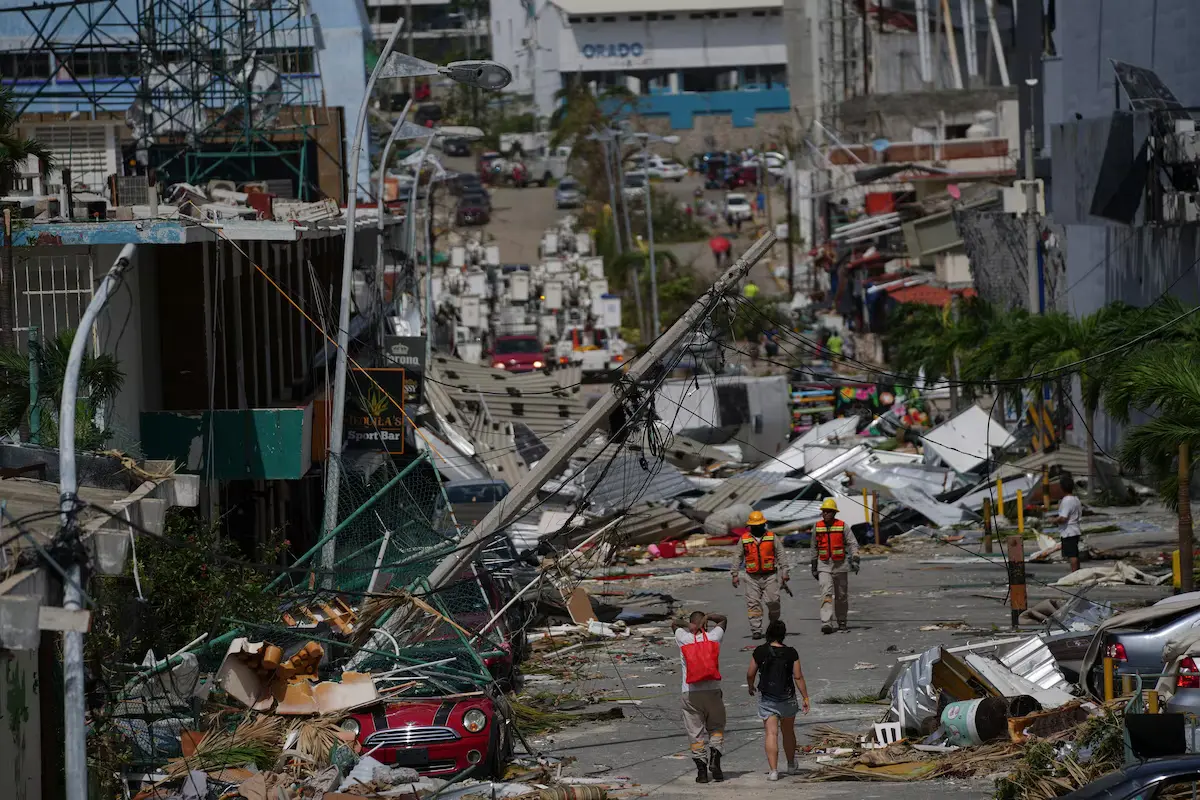News
Why Climate Change Is Now an Urgent Global Emergency – Exploring the Science and Solutions

(CTN News) – Climate change, a term that has lingered in the background for decades, has now risen to the forefront of global concerns. Scientists worldwide are increasingly using the term ’emergency’ to describe the situation. This article explores the reasons behind this sense of urgency and the implications for our planet.
The climate is undergoing significant and rapid changes, which have led scientists to categorize the situation as an emergency. This declaration signifies that immediate action is essential to prevent potentially catastrophic consequences. In this article, we will delve into the factors contributing to this shift in terminology and examine the pressing issues linked to climate change.
The Scientific Consensus
Data and Research
The shift towards labeling climate change as an ’emergency’ is grounded in solid scientific research. Over the years, the data collected has revealed alarming trends, such as the continuous rise in global temperatures and the increased frequency of extreme weather events. These trends paint a dire picture of the future.
Data-driven evidence plays a pivotal role in our understanding of climate change. Temperature records, ice core samples, and satellite observations all confirm the same troubling pattern: the Earth is warming at an unprecedented rate. Climate scientists rely on these data sources to predict future trends, and the outlook is concerning. The term ’emergency’ has been adopted to emphasize the severity and urgency of the situation.
Key Findings
Key findings include the fact that the past few decades have seen a significant increase in greenhouse gas emissions, primarily from human activities. This has resulted in a warmer planet, causing polar ice to melt and sea levels to rise, threatening coastal communities. Such findings underscore the urgency of addressing climate change.
Greenhouse gases, like carbon dioxide and methane, trap heat in the Earth’s atmosphere, leading to a greenhouse effect that warms the planet. This effect is primarily driven by human activities, such as the burning of fossil fuels, deforestation, and industrial processes.
The consequences are profound, with rising sea levels endangering low-lying coastal regions and impacting billions of people. These findings, supported by rigorous scientific research, drive the message home: immediate action is required to mitigate these effects.

Extreme Weather Events
Rising Temperatures
One of the most visible impacts of climate change is the rise in temperatures. Heatwaves are becoming more frequent and intense, resulting in a higher number of heat-related illnesses and deaths.
Rising temperatures are evident in prolonged and intense heatwaves that affect various regions of the world. These extreme heat events not only cause discomfort but also have dire consequences for human health.
Vulnerable populations, such as the elderly and children, are at risk of heat-related illnesses. Additionally, higher temperatures exacerbate issues like drought and water scarcity, affecting agriculture and food production.
Natural Disasters
Climate change also fuels natural disasters. Hurricanes, wildfires, and floods have become more destructive and deadly due to the changing climate. This poses a significant threat to human lives and infrastructure.
Extreme weather events, such as hurricanes and wildfires, are becoming more frequent and severe. These disasters result in loss of life, destruction of homes, and massive economic costs.
The intensity and frequency of such events are attributed to the warming of the Earth, which is linked to climate change. Scientists emphasize that these occurrences are no longer anomalies but part of a pattern that is escalating, making the ’emergency’ label apt.
Impact on Ecosystems
Biodiversity Loss
The natural world is also suffering. Ecosystems are disrupted, leading to biodiversity loss. Species are disappearing at an alarming rate, affecting the delicate balance of our planet’s ecosystems.
Biodiversity loss is a critical consequence of climate change. Ecosystems that once thrived are now under threat, resulting in the extinction of numerous species. This disruption has a profound impact on the environment and food chains, ultimately affecting human well-being. Scientists warn that the current rate of biodiversity loss is unsustainable and requires immediate intervention.
Ocean Acidification
The oceans, often called the Earth’s lungs, are absorbing excess carbon dioxide, causing ocean acidification. This disrupts marine life, with ripple effects on the entire food chain.
Ocean acidification is a lesser-known but equally significant consequence of climate change. The excess carbon dioxide in the atmosphere is absorbed by the oceans, causing them to become more acidic.
This harms marine life, especially creatures with calcium carbonate shells or skeletons, like corals and some types of plankton. These changes in ocean chemistry have a cascading effect throughout the food chain, ultimately impacting human populations that rely on seafood.
Human Health and Well-being
Air Quality
Climate change worsens air quality, increasing the prevalence of respiratory illnesses and making outdoor activities more hazardous.
As temperatures rise, the quality of the air we breathe is compromised. The increased occurrence of heatwaves and altered weather patterns leads to poor air quality, with a higher concentration of air pollutants.
This, in turn, contributes to respiratory illnesses, particularly in urban areas. The association between climate change and deteriorating air quality is clear, making it a pressing health concern.
Disease Spread
Warmer temperatures and altered precipitation patterns create ideal conditions for disease vectors, leading to the spread of diseases like malaria and dengue fever.
Climate change affects the distribution and behavior of disease-carrying vectors, such as mosquitoes. As temperatures rise, these vectors expand their habitats, leading to the spread of diseases like malaria and dengue fever to regions where they were previously uncommon. This poses a significant health risk to communities and requires proactive measures to prevent and control the diseases.
Economic Consequences
Agriculture and Food Security
Crop yields are under threat due to changing weather patterns, affecting food security globally. This can lead to food shortages and price spikes.
Agriculture, a cornerstone of human civilization, is under threat due to unpredictable weather patterns caused by climate change. Crops face challenges like droughts, floods, and new pests that affect yield and quality. As a result, food security becomes an issue, with the potential for food shortages and increased prices, particularly in vulnerable regions.
Insurance Costs
Increased frequency and severity of natural disasters put a massive financial burden on insurance companies, which, in turn, affects the global economy.
The surge in natural disasters has economic consequences. Insurance companies face growing claims due to the destruction caused by hurricanes, wildfires, and floods. As insurance costs rise, this financial burden extends to governments and individuals. The economic impact of climate change is not limited to these costs alone but also includes reduced productivity, property damage, and disruptions to supply chains.
Political Response
International Agreements
The international community has recognized the need to address climate change, resulting in agreements like the Paris Agreement. However, the urgency to meet the goals is increasing.
Global recognition of climate change as an emergency has led to international agreements aimed at curbing emissions and limiting temperature increases. The Paris Agreement, signed by 196 countries, is a landmark accord that commits nations to reducing their greenhouse gas emissions. However, the increasing urgency necessitates even more ambitious actions to meet the agreement’s goals and prevent catastrophic climate outcomes.
Policy Changes
Governments are adopting new policies and regulations to reduce emissions and promote sustainability. These changes aim to slow the progression of climate change.
Many governments are taking steps to address climate change. This includes policies to transition to cleaner energy sources, incentivize electric vehicles, and regulate industry emissions. These changes are vital in the fight against climate change and are an acknowledgment of the ’emergency’ status of the situation.
Technological Solutions
Energy
Transitioning to renewable energy sources like solar and wind power is crucial in reducing greenhouse gas emissions. Renewable energy offers a sustainable alternative to fossil fuels, as it produces electricity without emitting greenhouse gases. The widespread adoption of these technologies is essential to slowing down climate change.
The development of renewable energy technologies has reached a point where they are not only environmentally friendly but also economically viable. Solar panels and wind turbines are becoming more affordable and efficient, making them accessible for both individuals and large-scale energy projects.
Carbon Capture
Innovative technologies to capture and store carbon emissions are being developed to counteract the damage already done. Carbon capture involves trapping carbon dioxide emissions from industrial processes and power plants and storing them underground. This technology is a critical tool in reducing the overall carbon footprint and mitigating the effects of climate change.
Challenges and Obstacles
Skepticism and Denial
Despite overwhelming scientific evidence, some still deny the existence of climate change, hindering progress. Climate change denial remains a significant obstacle to collective action. While the scientific consensus is clear, a small but vocal minority continue to deny the reality of climate change. Overcoming skepticism and disinformation is crucial in garnering public and political support for climate action.
Economic Interests
Certain industries resist change due to financial interests tied to fossil fuels. This poses a significant challenge to the global response. Fossil fuel industries, including coal, oil, and natural gas, have powerful economic interests. Transitioning away from these energy sources threatens their profitability. This economic resistance can influence policy decisions and slow down the adoption of clean energy technologies.
The Role of Individuals
Lifestyle Changes
Every individual can contribute by adopting sustainable practices in their daily lives, from reducing waste to conserving energy. Lifestyle changes are within the reach of everyone. Simple actions like reducing, reusing, and recycling can help minimize waste and reduce the carbon footprint. Using public transportation, biking, or carpooling can reduce emissions from personal vehicles. These individual efforts, when multiplied across communities, have a substantial impact on reducing greenhouse gas emissions.
Advocacy
People can also support climate action by advocating for change through grassroots efforts and community involvement. Activism and advocacy are powerful tools for driving change. Individuals can join or support organizations dedicated to environmental conservation and climate action. They can also engage with local and national policymakers, voicing their concerns and demanding action on climate change.
Conclusion
In conclusion, the urgency of addressing climate change as an ’emergency’ cannot be overstated. The evidence is clear: climate change is real, and its impacts are already being felt globally. It is a global crisis that requires immediate, collective action from individuals, communities, governments, and industries. The adoption of sustainable practices, technological solutions, and policies to reduce emissions is essential to mitigate the effects of climate change and protect the future of our planet.

News
Trudeau’s Gun Grab Could Cost Taxpayers a Whopping $7 Billion

A recent report indicates that since Trudeau’s announcement of his gun buyback program four years ago, almost none of the banned firearms have been surrendered.
The federal government plans to purchase 2,063 firearm models from retailers following the enactment of Bill C-21, which amends various Acts and introduces certain consequential changes related to firearms. It was granted royal assent on December 15 of last year.
This ban immediately criminalized the actions of federally-licensed firearms owners regarding the purchase, sale, transportation, importation, exportation, or use of hundreds of thousands of rifles and shotguns that were previously legal.
The gun ban focused on what it termed ‘assault-style weapons,’ which are, in reality, traditional semi-automatic rifles and shotguns that have enjoyed popularity among hunters and sport shooters for over a century.
In May 2020, the federal government enacted an Order-in-Council that prohibited 1,500 types of “assault-style” firearms and outlined specific components of the newly banned firearms. Property owners must adhere to the law by October 2023.
Trudeau’s Buyback Hasn’t Happened
“In the announcement regarding the ban, the prime minister stated that the government would seize the prohibited firearms, assuring that their lawful owners would be ‘grandfathered’ or compensated fairly.” “That hasn’t happened,” criminologist Gary Mauser told Rebel News.
Mauser projected expenses ranging from $2.6 billion to $6.7 billion. The figure reflects the compensation costs amounting to $756 million, as outlined by the Parliamentary Budget Office (PBO).
“The projected expenses for gathering the illegal firearms are estimated to range from $1.6 billion to $7 billion.” “This range estimate increases to between $2.647 billion and $7 billion when compensation costs to owners are factored in,” Mauser stated.
Figures requested by Conservative MP Shannon Stubbs concerning firearms prohibited due to the May 1, 2020 Order In Council reveal that $72 million has been allocated to the firearm “buyback” program, yet not a single firearm has been confiscated to date.
In a recent revelation, Public Safety Canada disclosed that the federal government allocated a staggering $41,094,556, as prompted by an order paper question from Conservative Senator Don Plett last September, yet yielded no tangible outcomes.
An internal memo from late 2019 revealed that the Liberals projected their politically motivated harassment would incur a cost of $1.8 billion.
Enforcement efforts Questioned
By December 2023, estimates from TheGunBlog.ca indicate that the Liberals and RCMP had incurred or were responsible for approximately $30 million in personnel expenses related to the enforcement efforts. The union representing the police service previously stated that the effort to confiscate firearms is a “misdirected effort” aimed at ensuring public safety.
“This action diverts crucial personnel, resources, and funding from tackling the more pressing and escalating issue of criminal use of illegal firearms,” stated the National Police Federation (NPF).
The Canadian Sporting Arms & Ammunition Association (CSAAA), representing firearms retailers, has stated it will have “zero involvement” in the confiscation of these firearms. Even Canada Post held back from providing assistance due to safety concerns.
The consultant previously assessed that retailers are sitting on almost $1 billion worth of inventory that cannot be sold or returned to suppliers because of the Order-In-Council.
“Despite the ongoing confusion surrounding the ban, after four years, we ought to be able to address one crucial question.” Has the prohibition enhanced safety for Canadians? Mauser asks.
Illegally Obtained Firearms are the Problem
Statistics Canada reports a 10% increase in firearm-related violent crime between 2020 and 2022, rising from 12,614 incidents to 13,937 incidents. In that timeframe, the incidence of firearm-related violent crime increased from 33.7 incidents per 100,000 population in 2021 to 36.7 incidents the subsequent year.
“This marks the highest rate documented since the collection of comparable data began in 2009,” the criminologist explains.
Supplementary DataData indicates that firearm homicides have risen since 2020. “The issue lies not with lawfully-held firearms,” Mauser stated.
Firearms that have been banned under the Order-in-Council continue to be securely stored in the safes of their lawful owners. The individuals underwent a thorough vetting process by the RCMP and are subject to nightly monitoring to ensure there are no infractions that could pose a risk to public safety.
“The firearms involved in homicides were seldom legally owned weapons wielded by their rightful owners,” Mauser continues. The number of offenses linked to organized crime has surged from 4,810 in 2016 to a staggering 13,056 in 2020.
“If those in power … aim to diminish crime and enhance public safety, they ought to implement strategies that effectively focus on offenders and utilize our limited tax resources judiciously to reach these objectives,” he stated.
Related News:
Millennials in Canada Have Turned their Backs on Justin Trudeau
Millennials in Canada Have Turned their Backs on Justin Trudeau
News
Google’s Search Dominance Is Unwinding, But Still Accounting 48% Search Revenue

Google is so closely associated with its key product that its name is a verb that signifies “search.” However, Google’s dominance in that sector is dwindling.
According to eMarketer, Google will lose control of the US search industry for the first time in decades next year.
Google will remain the dominant search player, accounting for 48% of American search advertising revenue. And, remarkably, Google is still increasing its sales in the field, despite being the dominating player in search since the early days of the George W. Bush administration. However, Amazon is growing at a quicker rate.
Google’s Search Dominance Is Unwinding
Amazon will hold over a quarter of US search ad dollars next year, rising to 27% by 2026, while Google will fall even more, according to eMarketer.
The Wall Street Journal was first to report on the forecast.
Lest you think you’ll have to switch to Bing or Yahoo, this isn’t the end of Google or anything really near.
Google is the fourth-most valued public firm in the world. Its market worth is $2.1 trillion, trailing just Apple, Microsoft, and the AI chip darling Nvidia. It also maintains its dominance in other industries, such as display advertisements, where it dominates alongside Facebook’s parent firm Meta, and video ads on YouTube.
To put those “other” firms in context, each is worth more than Delta Air Lines’ total market value. So, yeah, Google is not going anywhere.
Nonetheless, Google faces numerous dangers to its operations, particularly from antitrust regulators.
On Monday, a federal judge in San Francisco ruled that Google must open up its Google Play Store to competitors, dealing a significant blow to the firm in its long-running battle with Fortnite creator Epic Games. Google announced that it would appeal the verdict.
In August, a federal judge ruled that Google has an illegal monopoly on search. That verdict could lead to the dissolution of the company’s search operation. Another antitrust lawsuit filed last month accuses Google of abusing its dominance in the online advertising business.
Meanwhile, European regulators have compelled Google to follow tough new standards, which have resulted in multiple $1 billion-plus fines.

Pixa Bay
Google’s Search Dominance Is Unwinding
On top of that, the marketplace is becoming more difficult on its own.
TikTok, the fastest-growing social network, is expanding into the search market. And Amazon has accomplished something few other digital titans have done to date: it has established a habit.
When you want to buy anything, you usually go to Amazon, not Google. Amazon then buys adverts to push companies’ products to the top of your search results, increasing sales and earning Amazon a greater portion of the revenue. According to eMarketer, it is expected to generate $27.8 billion in search revenue in the United States next year, trailing only Google’s $62.9 billion total.
And then there’s AI, the technology that (supposedly) will change everything.
Why search in stilted language for “kendall jenner why bad bunny breakup” or “police moving violation driver rights no stop sign” when you can just ask OpenAI’s ChatGPT, “What’s going on with Kendall Jenner and Bad Bunny?” in “I need help fighting a moving violation involving a stop sign that wasn’t visible.” Google is working on exactly this technology with its Gemini product, but its success is far from guaranteed, especially with Apple collaborating with OpenAI and other businesses rapidly joining the market.
A Google spokeswoman referred to a blog post from last week in which the company unveiled ads in its AI overviews (the AI-generated text that appears at the top of search results). It’s Google’s way of expressing its ability to profit on a changing marketplace while retaining its business, even as its consumers steadily transition to ask-and-answer AI and away from search.

Google has long used a single catchphrase to defend itself against opponents who claim it is a monopoly abusing its power: competition is only a click away. Until recently, that seemed comically obtuse. Really? We are going to switch to Bing? Or Duck Duck Go? Give me a break.
But today, it feels more like reality.
Google is in no danger of disappearing. However, every highly dominating company faces some type of reckoning over time. GE, a Dow mainstay for more than a century, was broken up last year and is now a shell of its previous dominance. Sears declared bankruptcy in 2022 and is virtually out of business. US Steel, long the foundation of American manufacturing, is attempting to sell itself to a Japanese corporation.
SOURCE | CNN
News
The Supreme Court Turns Down Biden’s Government Appeal in a Texas Emergency Abortion Matter.

(VOR News) – A ruling that prohibits emergency abortions that contravene the Supreme Court law in the state of Texas, which has one of the most stringent abortion restrictions in the country, has been upheld by the Supreme Court of the United States. The United States Supreme Court upheld this decision.
The justices did not provide any specifics regarding the underlying reasons for their decision to uphold an order from a lower court that declared hospitals cannot be legally obligated to administer abortions if doing so would violate the law in the state of Texas.
Institutions are not required to perform abortions, as stipulated in the decree. The common populace did not investigate any opposing viewpoints. The decision was made just weeks before a presidential election that brought abortion to the forefront of the political agenda.
This decision follows the 2022 Supreme Court ruling that ended abortion nationwide.
In response to a request from the administration of Vice President Joe Biden to overturn the lower court’s decision, the justices expressed their disapproval.
The government contends that hospitals are obligated to perform abortions in compliance with federal legislation when the health or life of an expectant patient is in an exceedingly precarious condition.
This is the case in regions where the procedure is prohibited. The difficulty hospitals in Texas and other states are experiencing in determining whether or not routine care could be in violation of stringent state laws that prohibit abortion has resulted in an increase in the number of complaints concerning pregnant women who are experiencing medical distress being turned away from emergency rooms.
The administration cited the Supreme Court’s ruling in a case that bore a striking resemblance to the one that was presented to it in Idaho at the beginning of the year. The justices took a limited decision in that case to allow the continuation of emergency abortions without interruption while a lawsuit was still being heard.
In contrast, Texas has been a vocal proponent of the injunction’s continued enforcement. Texas has argued that its circumstances are distinct from those of Idaho, as the state does have an exemption for situations that pose a significant hazard to the health of an expectant patient.
According to the state, the discrepancy is the result of this exemption. The state of Idaho had a provision that safeguarded a woman’s life when the issue was first broached; however, it did not include protection for her health.
Certified medical practitioners are not obligated to wait until a woman’s life is in imminent peril before they are legally permitted to perform an abortion, as determined by the state supreme court.
The state of Texas highlighted this to the Supreme Court.
Nevertheless, medical professionals have criticized the Texas statute as being perilously ambiguous, and a medical board has declined to provide a list of all the disorders that are eligible for an exception. Furthermore, the statute has been criticized for its hazardous ambiguity.
For an extended period, termination of pregnancies has been a standard procedure in medical treatment for individuals who have been experiencing significant issues. It is implemented in this manner to prevent catastrophic outcomes, such as sepsis, organ failure, and other severe scenarios.
Nevertheless, medical professionals and hospitals in Texas and other states with strict abortion laws have noted that it is uncertain whether or not these terminations could be in violation of abortion prohibitions that include the possibility of a prison sentence. This is the case in regions where abortion prohibitions are exceedingly restrictive.
Following the Supreme Court’s decision to overturn Roe v. Wade, which resulted in restrictions on the rights of women to have abortions in several Republican-ruled states, the Texas case was revisited in 2022.
As per the orders that were disclosed by the administration of Vice President Joe Biden, hospitals are still required to provide abortions in cases that are classified as dire emergency.
As stipulated in a piece of health care legislation, the majority of hospitals are obligated to provide medical assistance to patients who are experiencing medical distress. This is in accordance with the law.
The state of Texas maintained that hospitals should not be obligated to provide abortions throughout the litigation, as doing so would violate the state’s constitutional prohibition on abortions. In its January judgment, the 5th United States Circuit Court of Appeals concurred with the state and acknowledged that the administration had exceeded its authority.
SOURCE: AP
SEE ALSO:
Could Last-Minute Surprises Derail Kamala Harris’ Campaign? “Nostradamus” Explains the US Poll.
-

 News3 years ago
News3 years agoLet’s Know About Ultra High Net Worth Individual
-
Entertainment2 years ago
Mabelle Prior: The Voice of Hope, Resilience, and Diversity Inspiring Generations
-

 Health3 years ago
Health3 years agoHow Much Ivermectin Should You Take?
-

 Tech2 years ago
Tech2 years agoTop Forex Brokers of 2023: Reviews and Analysis for Successful Trading
-

 Lifestyles3 years ago
Lifestyles3 years agoAries Soulmate Signs
-

 Movies2 years ago
Movies2 years agoWhat Should I Do If Disney Plus Keeps Logging Me Out of TV?
-

 Health3 years ago
Health3 years agoCan I Buy Ivermectin Without A Prescription in the USA?
-

 Learning2 years ago
Learning2 years agoVirtual Numbers: What Are They For?
